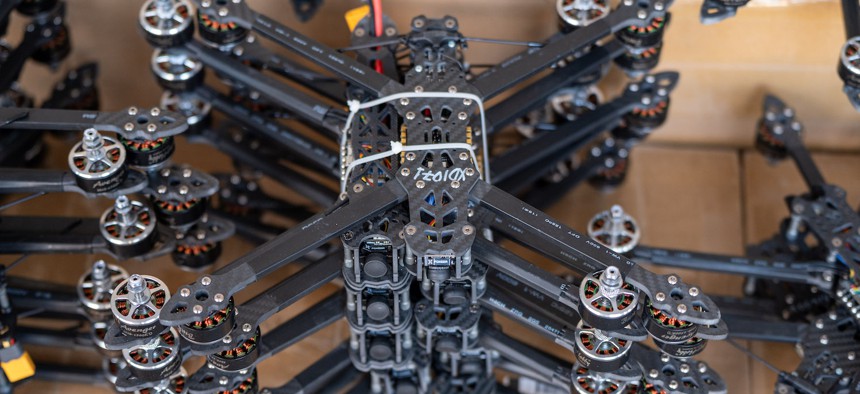
FPV drones lie on boxes during transfer by volunteers to the units of the Armed Forces of Ukraine on January 22, 2024 in Lviv, Ukraine. Stanislav Ivanov / Global Images Ukraine via Getty Images
UK, Latvia launch effort to send thousands of FPV drones to Ukraine
It’s not yet clear whether these will be militarized or civilian models.
Britain and Latvia will co-lead an effort to send Ukraine thousands of first-person-view (FPV) drones, which Ukrainian and Russian forces have used in vast numbers as improvised loitering munitions.
At least some will come from British manufacturers, according to a British Ministry of Defense press release issued Thursday. The order will be the first use of a 200 million pound ($252 million) fund created in January to supply Ukraine with drones, the release said.
The press release did not identify the drone vendors, nor whether the MoD will buy commercially available models or ones produced with military applications in mind.
Some Western companies are producing quadcopter drones designed explicitly for bombing. PDW, for example, markets a militarized drone that appears visually similar to those used in Ukraine. It is resistant to electronic warfare, and flyable in bad weather, according to the company website.
FPV drones are fast, commercially available racing drones that Ukraine and Russia have re-purposed by strapping explosives to them. Britain’s army has long used FPVs for their original function: racing. The army first fielded an FPV drone racing team in 2017.
The drones have been an important way for Ukraine to balance Russia’s overwhelming superiority in long-range munitions such as artillery shells. Ukraine currently fires as few as 2,000 shells to Russia’s 10,000 amid deadlock in Congress over approving more aid for Ukraine.
Ukraine’s lack of ammunition for targeting Russian artillery has been key to recent Russian advances, such as toward the nearly encircled Ukrainian town of Avdiivka.
Ukrainian pilots say they typically only manage to to hit one out of every five targets due to accidents, bad weather, and Russian anti-air capabilities. Still, even one strike may be a major win, with some strikes taking out Russian equipment valued in the millions of dollars.
Pilot training is a limiting factor, however, with each pilot needing around 30 days to become a proficient pilot, according to course instructors, compared to the several days it takes to learn to fly the photography quadcopters used to drop bombs and coordinate artillery fire.
While the drones can be bought already assembled, both Ukraine and Russia also produce large numbers of the drones in home workshops, relying on cheap components bought from China. Some variants may cost as little as $400.
Ukraine manufactures as many as 50,000 FPV drones a month, while Russia may produce a similar or higher number, said Samuel Bendett of the Center for Naval Analysis. Ukraine hopes to produce as many as one million drones in 2024.
Builders of the drones, however, must contend with complex supply networks. Many FPV components come from China, which some builders say are not enthusiastic about helping Ukraine.




